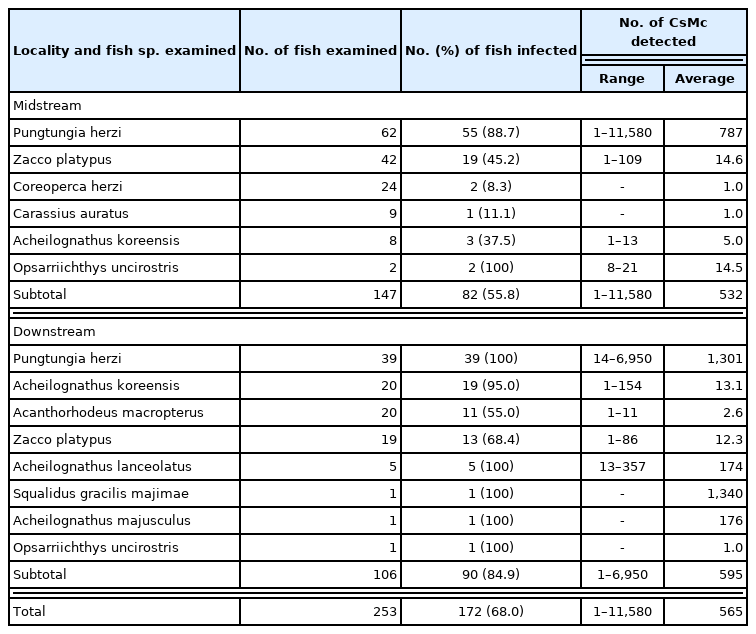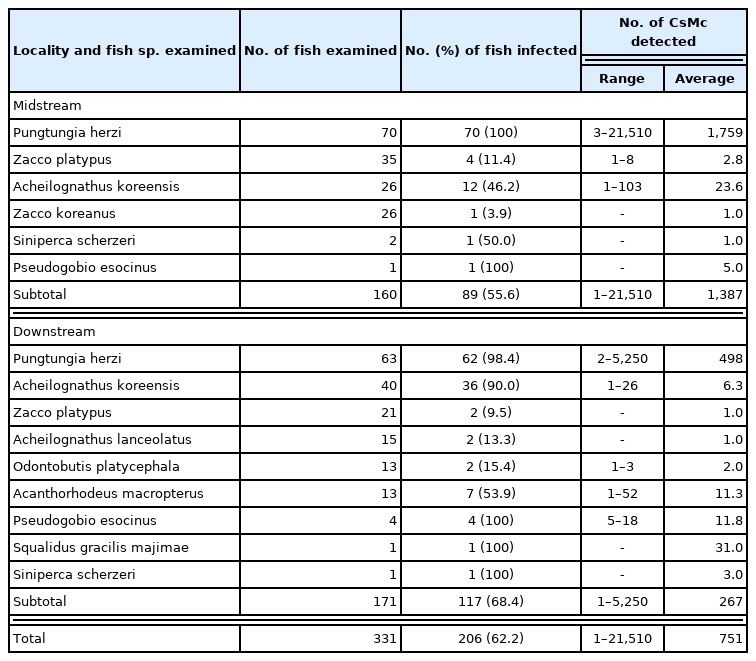High Endemicity with Clonorchis sinensis Metacercariae in Fish from Yongjeon-cheon (Stream) in Cheongsong-gun, Gyeongsangbuk-do, Korea
Article information
Abstract
The infection status with Clonorchis sinensis metacercariae (CsMc) was examined in freshwater fishes from Yongjeon-cheon (a branch of Nakdong-gang) located in Cheongsong-gun, Gyeongsangbuk-do, the Republic of Korea (Korea). A total of 750 fishes in 19 species were examined by the artificial digestion method for 2 years (2019 and 2020). CsMc were detected in 378 (51.4%) out of 735 fishes in 14 species (73.7%), and the infection intensity was 666 per fish infected. In 2019, CsMc were found in 172 (68.0%) out of 253 fishes in 10 species, and the infection intensity was 565 per fish infected. In 2020, CsMc were detected in 206 (62.2%) out of 331 fishes in 10 species, and the infection intensity was 751 per fish infected. The other zoonotic trematode, ie. Metagonimus spp., Centrocestus armatus, Echinostoma spp. and Clinostomum complanatum, metacercariae were also detected in fishes from the survey streams, but their endemicities were relatively low. Conclusively, it was first confirmed that CsMc are highly endemic in fishes from Yongjeon-cheon in Cheongsong-gun, Gyeongsangbuk-do, Korea.
Nowadays, clonorchiasis, Clonorchis sinensis (Digenea: Opisthorchiidae) infection, is most important as an endemic parasitic disease in the Republic of Korea (Korea) [1]. The prevalence of clonorchiasis has maintained at relatively high levels in the residents of riverside areas in Korea. A team of Korea DCPA (Division of Vectors and Parasitic Diseases, Korea Disease Control and Prevention Agency) has performed the control programs to decrease the prevalence of clonorchiasis in the residents of major river basins in Korea [2–6]. On the other hand, co-working groups of Korea DCPA have epidemiologically surveyed the freshwater fishes, the infection sources, to estimate the endemicities of clonorchiasis [6–11]. Especially, Cho et al. [6] investigated the infection status of CsMc in freshwater fish from various regions of Korean peninsula. Sohn et al. [8] and Yoon et al. [9] investigated the infection status of CsMc in freshwater fishes from the water systems of Seomjin-gang and Tamjin-gang. Recently, Sohn et al. [10,11] also surveyed the infection status of CsMc in freshwater fish from 2 highly endemic areas, Wi-cheon (cheon means stream) and Yang-cheon (branch streams of Nakdong-gang), in Gunwi-gun (gun= county), Gyeongsangbuk-do and Sancheong-gun, Gyeongsangnam-do, Korea.
Yongjeon-cheon is one of the branch stream of Nakdong-gang, which rise from a mountinous area (Guam-san) (san means mountain) of Bunam-myeon (myeon=township), flows via Juwangsan-myeon and Cheongsong-eup (eup=town) unites with Banbyeon-cheon in Pacheon-myeon, Cheongsong-gun, Gyeongsangbuk-do. This stream flows only in Cheongsong-gun areas as the most big stream in Cheongsong-gun [12]. A riverside area of Yongjeon-cheon was reported as a high endemic area of echinostomiasis [13]. However, the infection status with zoonotic trematode metacercariae (ZTM) including CsMc in fish from this area has not been widely and systematically examined yet. Therefore, we intended to investigate the infection status with CsMc in fishes from Yongjeon-cheon for 2 years, 2019 and 2020.
We collected a total of 750 freshwater fishes in 19 species in 2 sites, midstream (Cheongwoon-ri in Cheongsong-eup: 36. 39995; 129.07015), and downstream (Gwan-ri in Pacheon-myeon: 36.44223; 129.03083), of Yongjeon-cheon (a branch stream of Nakdong-gang), which is located in Cheongsong-gun, Gyeongsangbuk-do, Korea for 2 years (2019 and 2020). In the midstream, a total of 382 freshwater fish in 12 species were examined, and the fish species (No. of fish) examined were as follows: Pungtungia herzi (132), Zacco platypus (77), Zacco koreanus (54), Coreoperca herzi (40), Acheilognathus koreensis (34), Odontobutis platycephala (22), Carassius auratus (11), Coreoleuciscus splendidus (6), Opsariichthys uncirostris (2), Siniperca scherzeri (2), Squalidus gracilis majimae (1), Pseudogobio esocinus (1). Total 368 freshwater fish in 18 species from downstream were examined, and the fish species (No. of fish) examined were as follows: P. herzi (102), A. koreensis (60), Z. koreanus (44), Z. platypus (40), Acanthorhodeus macropterus (33), C. herzi (26), Acheilognathus lanceolatus (20), O. platycephala (19), C. auratus (6), Micropterus salmoides (6), P. esocinus (4), O. uncirostris (1), S. gracilis majimae (2), Acheilognathus majusculus (1), Hemibarbus longirostris (1), Hemibarbus labeo (1), Acheilognathus rhombeus (1), S. scherzeri (1).
All collected fishes were transferred to the laboratory of the Department of Parasitology and Tropical Medicine, Gyeongsang National University College of Medicine, Jinju, Korea. After the identification of fish species [14], they were individually examined by the artificial digestion method [15,16]. Collected CsMc were counted to get hold of prevalences (No. of fish with CsMc/No. of fish examined×100) and infection intensities (No. of CsMc/a fish infected) by fish species.
The metacercariae of C. sinensis (CsMc) were detected in 378 (51.4%) out of 735 fishes in 14 species (73.7%), and the infection intensity was 666 per fish infected. The infection status by the fish species and fish group (subfamilies in Cyprinidae) was shown in Table 1. In 2019, CsMc were detected in 172 (68.0%) out of 253 fishes in 10 species, and the infection intensity was 565 per fish infected. The infection status by the fish species and survey site was detailedly revealed in Table 2. In 2020, CsMc were detected in 206 (62.2%) out of 331 fishes in 10 species, and the infection intensity was 751 per fish infected. The infection status by the fish species and survey site was designated in Table 3 in detail.

Overall infection status of Clonorchis sinensis metacercariae by the fish species from Yongjeon-cheon in Cheongsong-gun, Gyeongsangbuk-do, Korea

Infection status of Clonorchis sinensis metacercariae in fishes from Yongjeon-cheon in Cheongsong-gun, Gyeongsangbuk-do (2019)

Infection status of Clonorchis sinensis metacercariae in fishes from Yongjeon-cheon in Cheongsong-gun, Gyeongsangbuk-do (2020)
Metagonimus spp. metacercariae were found in 304 (42.9%) out of 708 fishes in 11 species (57.9%), and the infection intensity was 14.6 per fish infected. The metacercariae of Centrocestus armatus were detected in 167 (38.7%) out of 431 fishes in 7 species (36.8%), and the infection intensity was 615 per fish infected. Echinostoma spp. metacercariae were found in 310 (42.3%) out of 733 fishes in 13 species (68.4%), and the infection intensity was 29.6 per fish infected. The metacercariae of Clinostomum complanatum were detected in 85 (15.1%) out of 564 fishes in 6 species (31.6%), and the infection intensity was 3.2 per fish infected (Table 4).
By the present study, it was confirmed for the first time that CsMc are highly endemic in fishes from Yongjeon-cheon, in Cheongsong-gun, Gyeongsangbuk-do, Korea. The infection status was revealed with a certain tendency by the subfamily groups, i.e., Gobioninae, Acheilognathinae and Rasborinae, in the cyprinid fish (family Cyprinidae) hosts of C. sinensis like in Sohn et al. [10,11]. The prevalences of CsMc were 96.2%, 64.9% and 19.3%, and infection intensities with CsMc were 1,094, 20 and 11 per fish infected in 3 fish groups respectively. In this study, prevalences and infection intensities are somewhat lower than those in fish from Wi-cheon [10], but much higher than those in fish from Yang-cheon [11]. And then, we can also know that the endemicity of CsMc is closely related with the subfamily groups, i.e., Gobioninae, Acheilognathinae and Rasborinae, in the cyprinid fish hosts from a highly endemic area, Yongjeon-cheon, in Cheongsong-gun, Gyeongsangbuk-do, Korea.
The ecological conditions for fish was not so good in Yongjeon-cheon. Total 750 freshwater fishes in 19 species were collected in 2 survey sites of Yongjeon-cheon in this study. Among them, striped shinner (P. herzi: 31.2%), was the most dominant fish species like in Tamjin-gang [9] and Wi-cheon [10] and in Yang-cheon [11], and followed by pale chub (Z. platypus: 15.6%), Korean chub (Z. koreanus: 13.1%), oily bitterling (A. koreensis: 12.5%), Korean aucha perch (C. herzi: 8.8%), Korean dark sleeper (O. platycephala: 5.5%), deep body bitterling (A. macropterus: 4.4%), slender bitterling (A. lanceolatus: 2.7%) and crusian carp (C. auratus: 2.3%). The number of fish examined was 720 (96.0%) in major 9 species and 30 (4.0%) in remain 10 species. The disproportion of fish number and a small number of fish species examined is suggested that the ecological condition for fish was relatively not so good.
Edible fish species in raw, i.e., Korean aucha perch (C. herzi), Korean dark sleeper (O. platycephala), crusian carp (C. auratus) and Mandarin fish (S. scherzeri), practically act as the infection sources of clonorchiasis in Korea. Fortunately, these fish species are less prevalent with CsMc like in such a highly endemic area, Wicheon [10]. In this study, 2 (3.0%) out of 66 C. herzi were infected with 2 CsMc, 2 (4.9%) of 41 O. platycephala were infected with total 4 CsMc, only 1 (5.9%) out of 17 C. auratus were retained with 1 CsMc and 2 (66.7%) S. scherzeri were infected with a total of 4 CsMc. CsMc were not detected at all in 4 fish species, i.e., C. herzi (n=57), C. auratus (42), S. scherzeri (11) and C. carpio (2), from the water systems of Seomjin-gang [8]. Only one CsMc were found in only 1 (1.1%) out of 93 C. herzi and no CsMc were detected from 73 C. auratus, 36 O. platycephala and 1 S. scherzeri from Yang-cheon in Sancheong-gun, Gyeongsangnam-do, Korea [11].
The striped shinner, P. herzi, is regarded as the index fish species of CsMc infection, so this fish species is broadly live in the water systems of Korea and is highly susceptibe with CsMc. The proportion of this fish species examined were 12.3% in Seomjin-gang [8], 13.5% in Tamjin-gang [9], 14.5% in Wicheon [10], 24.3% in Yang-cheon [11] and 31.2% in this study. In this study, total 226 (96.6%) P. herzi were infected with 1,098 CsMc in average. Therefore, the endemicity (susceptibility index=prevalence/100×No. of CsMc in average) was 1,060.7. This value is somewhat lower than that (1,550) in Wi-cheon [10]. However, it is higher than those in Seomjin-gang (34.8) [8], Tamjin-gang (103.2) [9] and Yang-cheon (146.4) [11]. Accordingly, based on the susceptibility index of CsMc in the index fish, P. herzi, we can know that Wi-cheon and Yongjeon-cheon are highly endemic, Yang-cheon and Tamjin-gang are moderately endemic, and Seomjin-gang is more or less low endemic areas.
Conclusively, it is confirmed for the first time that CsMc is highly endemic in fishes, especially in P. herzi, from Yongjeon-cheon and the infection tendency of CsMc is obviously showed by 3 subfamily groups, i.e., Gobioninae, Acheilognathinae and Rasborinae, in the family Cyprinidae fish hosts from Yongjeon-cheon in Cheongsong-gun, Gyeongsangbuk-do, Korea.
ACKNOWLEDGMENTS
This study was supported by an anti-communicable diseases control program, 2019 and 2020 (Investigation and analysis on the infections of zoonotic trematode metacercariae in fish intermediate hosts in the Republic of Korea) of Division of Vectors and Parasitic Diseases, Korea Centers for Disease Control and Prevention (KCDCP). This work was partly supported by the Gyeongsang National University Fund for Professors on Sabbatical Leave, 2020. We thank Jung-A Kim, Hee-Joo Kim and You-Jin Ryu (Department of Parasitology and Tropical Medicine, Gyeongsang National University College of Medicine, Jinju, Korea), for their help in the examination of fish.
Notes
CONFLICT OF INTEREST
The authors have no conflicts of interest concerning the work reported in this paper.

